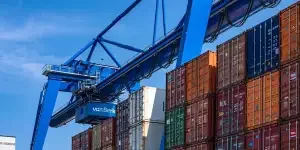The relationship between businesses and global supply chains is similar to that of a boxer with a ring. Constantly, they are dodging punches – whether it be pandemics, increasing tariffs, or just the shady cloud of world politics.
Supply chain disruptions? Yes, they’re pretty much inevitable. Businesses can’t predict or prevent them entirely, but what they can control is how they react and manage them proactively.
This might sound a little bit scary, but according to a recent study published by KPMG, businesses might soon be facing more curveballs; from shortages of critical manufacturing materials to some serious fluctuations in product prices. With all this uncertainty, how can businesses make sure their supply chains remain strong when things get tough?
Continue reading to discover what makes a supply chain resilient, the benefits of having one, and how to develop a supply chain resilience model in just four simple steps!
Table of Contents
What is a resilient supply chain?
What are the benefits of resilient supply chains?
How to build resilient supply chains?
Resilience is the cornerstone of managing supply chains
What is a resilient supply chain?
Just picture this: a sudden global pandemic or a natural disaster strikes, throwing a wrench into the day-to-day operations of a business. It sounds messy, right? But businesses that have a resilient supply chain ace it, even under those daunting circumstances.
Simply put, a resilient supply chain allows businesses to adapt quickly and effectively to whatever disruptions may come their way. This flexibility allows them to continue humming along, delivering efficiency, even when it seems like the world wants to put everything on pause.
Supply chain resilience is like having an intricate clockwork mechanism, and even if you lose one cog (or there’s a disruption in the normal flow of goods and services), the rest of the cogs keep turning smoothly. This requires meticulously arranged contingency plans in place, ensuring that, come what may, businesses can keep functioning with optimal performance, experiencing as little disruption as possible.
What are the benefits of resilient supply chains?
In today’s dynamic business world, understanding why supply chain resilience is important can be a definitive game-changer. The ability to recover from disruptions and continue to operate as usual can help businesses in three key ways:
Improved risk management
By proactively anticipating and managing supply chain disruptions, businesses can prepare for a myriad of challenges, from poor weather to unforeseen supplier shutdowns. Having a contingency plan for each potential risk not only ensures that operations run smoothly in the short term but also safeguards long-term productivity. It’s not just about predicting what could go wrong—it’s more about how to mitigate those problems when they do occur.
More flexibility and adaptability
Besides helping in the mitigation of logistical risks, supply chain resilience enhances flexibility and adaptability. This is especially important when dealing with global supply chains in volatile markets, where customer needs are frequently evolving and often unpredictable. With a resilient supply chain, businesses can swiftly adapt to these changing market conditions in real time.
Competitive cost optimization
A resilient supply chain also minimizes downtime and reduces unnecessary costs when faced with unexpected disruptions. By continuing to function normally under such circumstances, companies can maintain their production and delivery cycles, thereby avoiding costly delays. Furthermore, supply chain resilience leads to improved inventory management, allowing businesses to better handle demand fluctuations and prevent lost sales.
How to build resilient supply chains?
By having a resilient supply chain, businesses can withstand the unforeseen and bounce back with minimal impact. Here is a four-step framework for building a resilient supply chain—and don’t worry, it’s not as complicated as it sounds.
Establish end-to-end visibility
Visibility forms the cornerstone of supply chain resilience. For supply chain managers, an unobstructed, real-time snapshot of ongoing logistics operations allows them to rapidly respond to unexpected challenges. This proactive supply chain management ensures control over every single step, from sourcing the raw materials to the eventual delivery of the product.
An innovative approach to achieve this end-to-end visibility is through a digital twin. Essentially, a digital twin is a dynamic replica of a company’s supply chain, mirroring the nuances of operations, assets, processes, and transactions in real time. It’s like having a real-time GPS navigation system that shows businesses the current location, traffic, and alternate routes for their supply chain operations.
A powerful solution for creating digital twins is Alibaba Cloud’s Industrial Brain. This smart tool provides businesses with AI algorithms and big data analysis, allowing them to transform their sprawling supply chain information into a manageable digital brain. This centralized system not only supports end-to-end visibility with tangible insights but also provides immediate feedback, ensuring companies stay ahead of the game.
Identify and prioritize logistics risks
Working within a global supply chain can be likened to solving a complex puzzle where one misplaced piece can affect the entire picture. This is why, after establishing clear visibility, the second step to supply chain resilience is developing a logistics risk management strategy.
This risk management framework is essentially a brainstorming session to identify all conceivable supply chain disruptions, be it natural disasters that could damage infrastructure, country-specific trade regulations, or cybersecurity threats lurking in the shadows.
Following the identification phase comes ‘risk prioritization‘. These risks should be ranked based on the severity of their potential impact on the supply chain, the likelihood of their occurrence, and how easily they can be prevented. As a part of this step, businesses must also create a playground rulebook – a mitigation plan tailored for each risk.
These plans should include the following elements:
- A comprehensive account of the potential supply chain disruption and its cause;
- The implemented strategies and cost implications to prevent or minimize the impact;
- A timeline for remedial actions;
- An analysis of the ripple effect any changes might have on other operational areas.
Put simply, by keeping an eagle eye on the risks and standing prepared with a shield and rulebook, businesses can build a resilient supply chain that can withstand any storm.
Standardize and diversify the supplier network

Building a resilient supply chain is like weaving a strong net; each knot has a crucial role. As such, businesses need a diversified supplier network. Here’s why it matters – let’s say one of your suppliers, or even their upstream suppliers, faces a setback. Even if it doesn’t immediately seem to affect you, it’s like a game of dominoes where each tile affects the next and your business might feel the tremors several months later!
Having suppliers in different parts of the world creates a safety net where risk is spread out, and not bunched up in one place. Picture this – if one supplier hits a roadblock, businesses need others who can step in, take over, and keep things running smoothly. But undergoing the effort of diversifying suppliers is just half the battle won.
While having primary and backup suppliers is crucial, what’s equally important is to have a standardized evaluation checklist to measure each supplier’s performance. Here are some key performance indicators (KPIs) for effective performance monitoring of suppliers:
Financial stability: A financially secure supplier is more likely to fulfill obligations and stay in business.
Adaptability and flexibility: Look for suppliers who can adapt to changing market conditions and respond quickly to disruptions.
Comprehensive visibility: Ensure they have clarity into their own supply chains (including tier-2 suppliers and beyond).
Communication effectiveness: Clear and efficient communication about capabilities and limitations is crucial.
Additionally, remember to follow the best practices of strategic supplier management to ensure strong relationships:
- Setting clear expectations through regular communication.
- Avoiding unreasonable demand schedules.
- Recognizing suppliers’ achievements.
- Proactively managing contracts by negotiating renewals in advance.
Empower teams and individuals
The final part of our four-step supply chain resilience model is employee empowerment. It’s crucial to remember that resilience isn’t solely about having backup plans at the ready. As importantly, it’s about the capacity to execute these plans effectively, even in high-stake scenarios or emergencies.
The foundation of a resilient supply chain is the empowerment of individuals, which encourages decision-making across all levels. When businesses entrust their employees with authority, they are furnishing them with the needed tools to make decisions confidently.
Interestingly, it’s often those closest to daily operational tasks who can detect and anticipate disruptions well before they ascend the ladder to catch management’s attention. This potential can be maximized by cultivating an environment of openness, where every employee feels at ease voicing their worries or proposing solutions.
Here are five key tips to foster a culture of decision-making among team members:
- Share information across departments: Everyone should be aware of the company’s happenings.
- Don’t micromanage: Businesses should give their teams autonomy within their company’s standards.
- Assign ownership of projects: Make employees feel like a tangible part of the entity rather than a simple cog in the wheel.
- Promote open communication: Encourage team members to voice out issues or innovative ideas freely.
- Appreciate good work: Celebrate team members’ milestones and their efforts with simple rewards.
Resilience is the cornerstone of managing supply chains
Having a resilient supply chain is an absolute necessity in this ever-fluctuating business landscape. Resilient supply chains not only enable businesses to swiftly and effectively manage disruptions but they also help to keep their impact to a minimum, facilitating a rapid return to normal operations.
The magic formula? It’s all about establishing processes that swiftly pinpoint potential supply chain disruptions before they explode into full-blown crises. A well-organized mitigation plan coupled with the know-how of when and how to deploy it, is the heart of a robust, resilient supply chain.
Remember, an efficient supply chain is the secret weapon against disruptions. So make sure your supply chain is operating at maximum efficiency by following these 5 critical steps!

Looking for a logistics solution with competitive pricing, full visibility, and readily accessible customer support? Check out the Alibaba.com Logistics Marketplace today.



